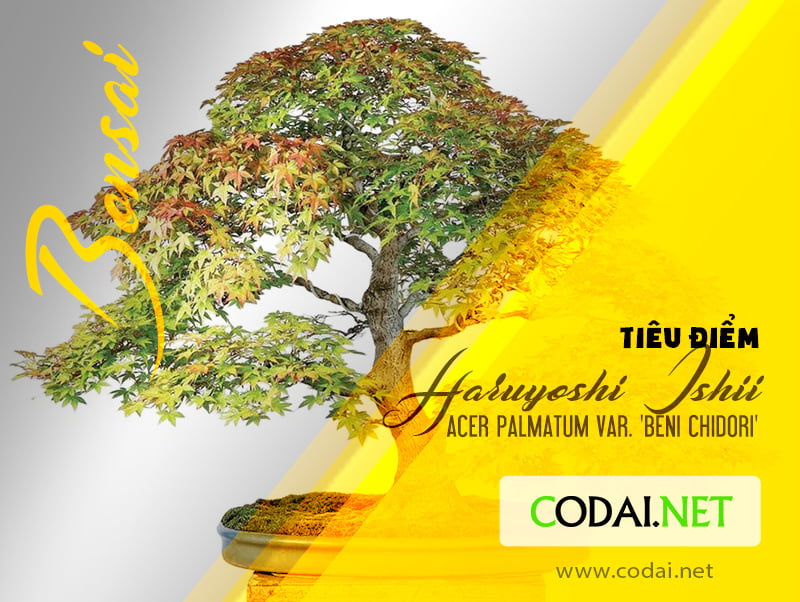Bonsai, Bonsai Focus Magazine, Chia sẻ kinh nghiệm, Người nổi tiếng
Cao thủ Bonsai Haruyoshi Ishii (Ueharu-en) cứu một cây Phong Beni Chidori (Acer palmatum var. ‘Beni Chidori’)
Nguồn: Tạp chí Bonsai Focus English Edition T9/T10 2016
Dịch và biên tập: Dũng Cá Xinh (15/08/2021)
English
On the road to recovery Acer palmatum
- Text and photography Kinbon magazine Skills: Mr Haruyoshi Ishii (Ueharu-en)
This maple was suffering from weakness anddying branches due to being pot bound and unable to absorb water. A ‘dam’ was created around the pot rim in order to stop waterfrom rolling off the surface. Here we see theresults of that technique and monitor therejuvenation of the tree.
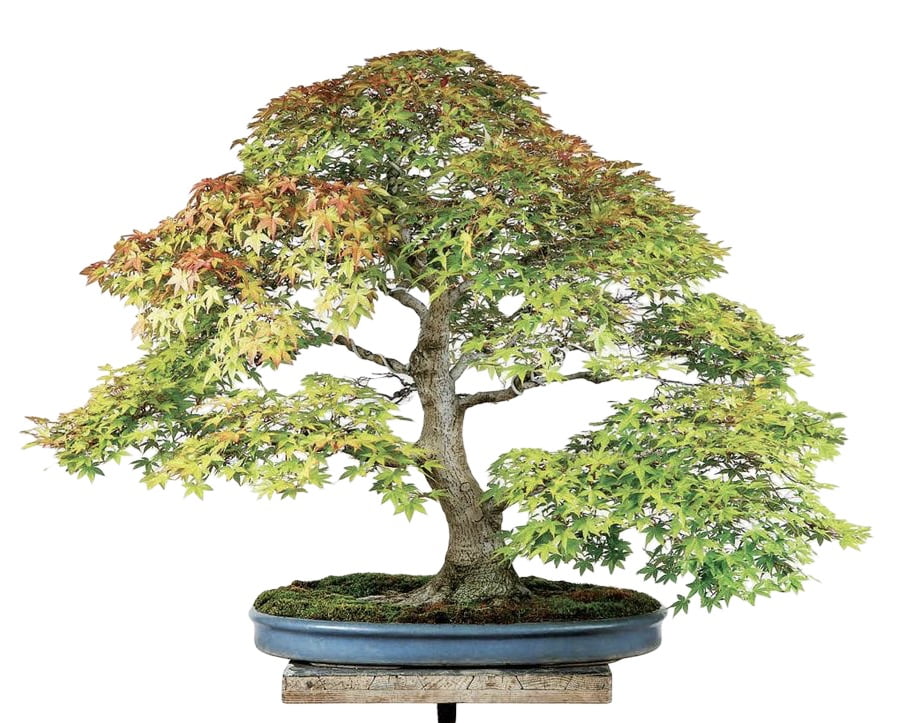
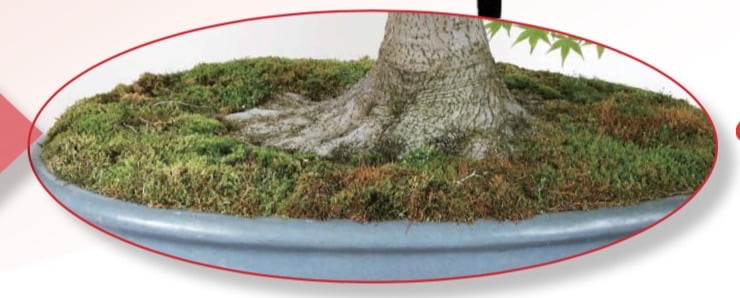



- Now a second rope is added and in between the two, fertiliser cakes are placed. Water will collect and help to dissolve the fertiliser, aiding the recovery of the tree
- The number of leaves has been reduced to balance the roots with the amount of transpiration. In this situation, in the height of summer, it is not possible to transplant the tree and this emergency measure is the best course to take
- Nine months after the previous work, transplanting season has arrived
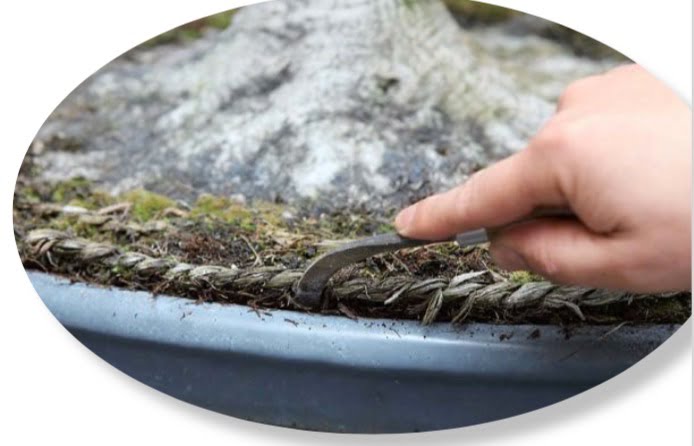
- The work begins by inserting the root saw
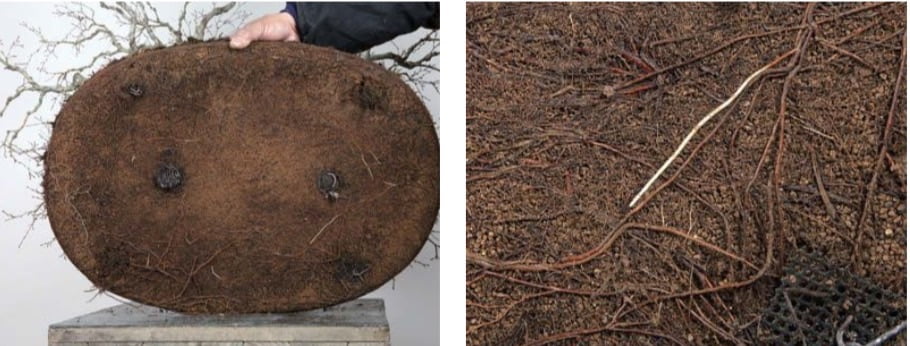
6th March 2012
The dam put in place last June was a stopgap measure until the traditional time for transplanting. Close inspection of the roots shows no major signs of root rot, rather a number of thick roots which have raced around the pot. In the centre of this we can see some fine, white new roots.
The effectiveness of the dam can be seen in this result. Water was able to reach the roots whereas previously it had not done so, causing the branches to die. When a tree becomes pot bound and roots are so dense, it is essential to make sure that water penetrates the centre of the pot.
The root ball

- The outer circumference is broken down a little and the main soil is removed
- This time there will be a complete refreshing of the, washing the roots clean
- Using a jet spray to remove the old soilsoil
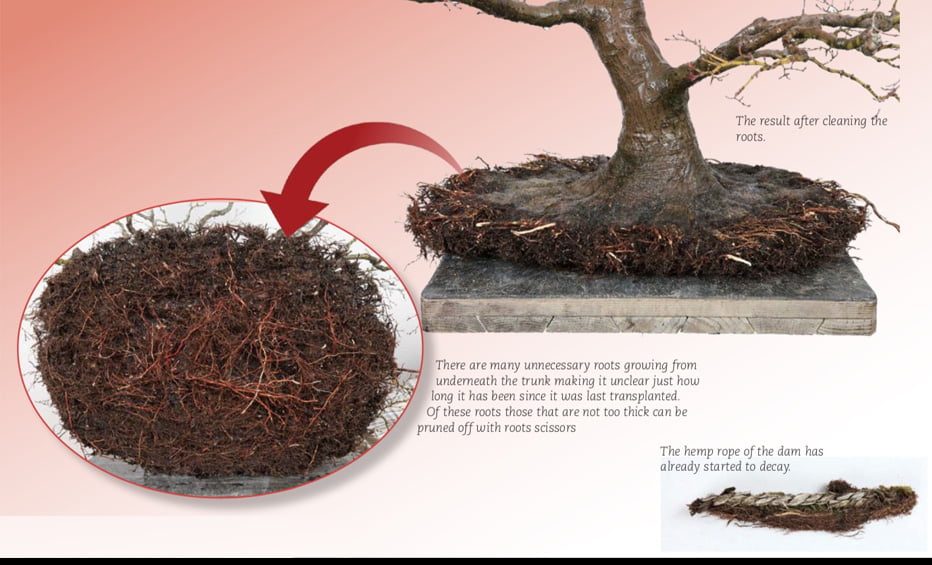
- The result after cleaning the roots.
- There are many unnecessary roots growing from underneath the trunk making it unclear just how long it has been since it was last transplanted. Of these roots those that are not too thick can be pruned off with roots scissors
- The hemp rope of the dam has already started to decay.
Dealing with the roots
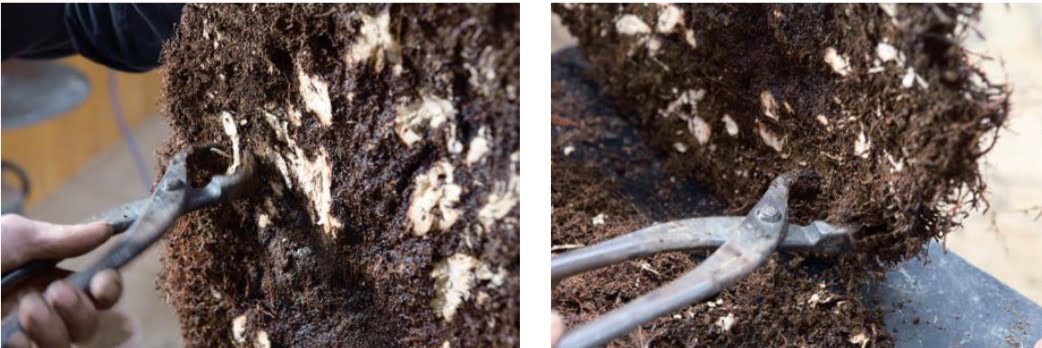
- The downward growing roots are always to be cut back, in this case using concave cutters
- A thick, heavy root is removed close to the outer edge using cutters
From the bottom of the thick and entwined root ball we see that a number of fine roots are emerging. This is not what we want to happen; we would prefer to have lateral roots emerging from higher up the tree. In order to stop roots from growing under the trunk and root ball, it will be cut back as aggressively as possible. It’s the next step on the road to recovery.
Dealing with the surface roots
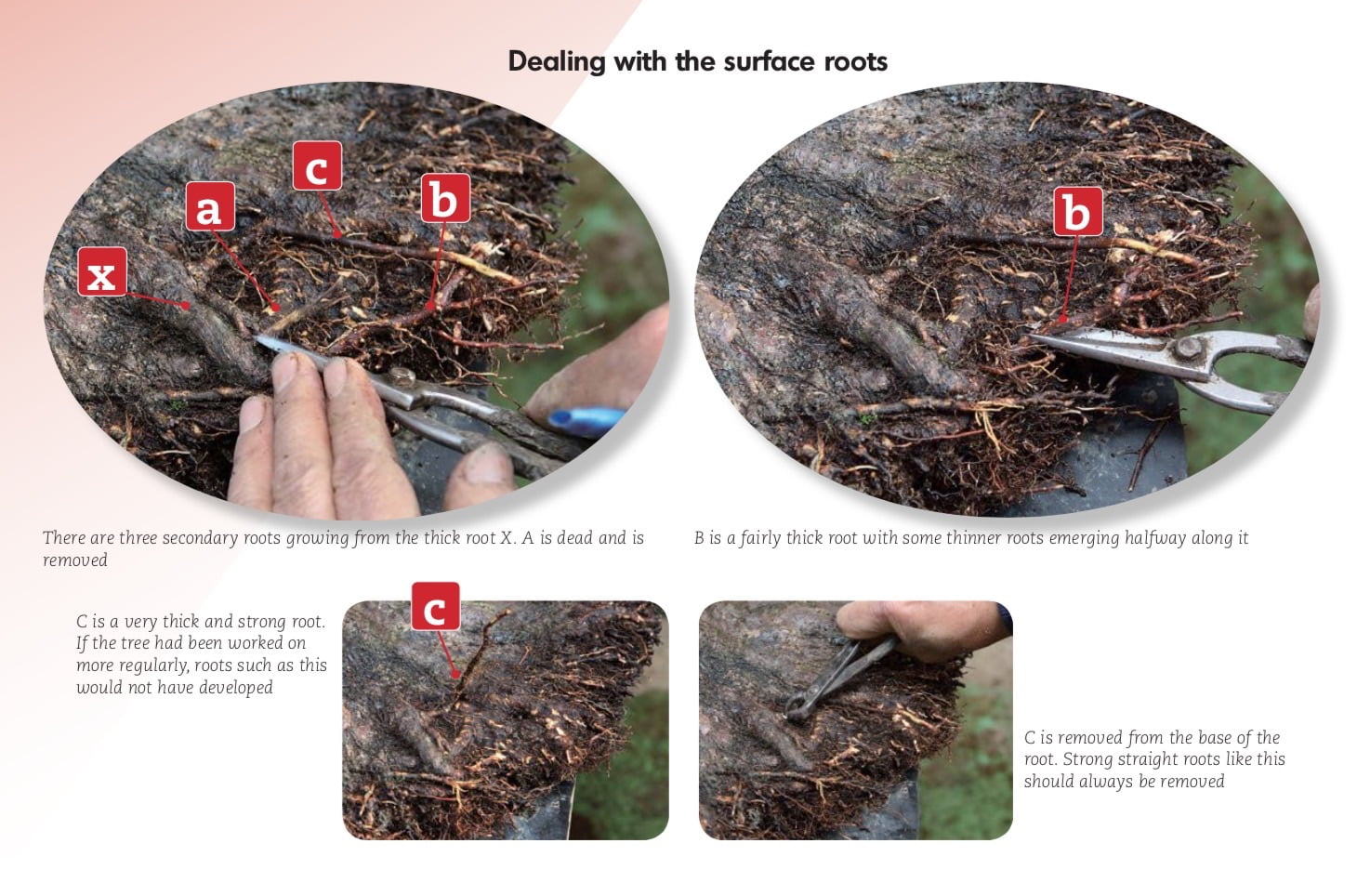
- There are three secondary roots growing from the thick root X. A is dead and is removed
- B is a fairly thick root with some thinner roots emerging halfway along it
- C is a very thick and strong root. If the tree had been worked on more regularly, roots such as this would not have developed
- C is removed from the base of the root. Strong straight roots like this should always be removed
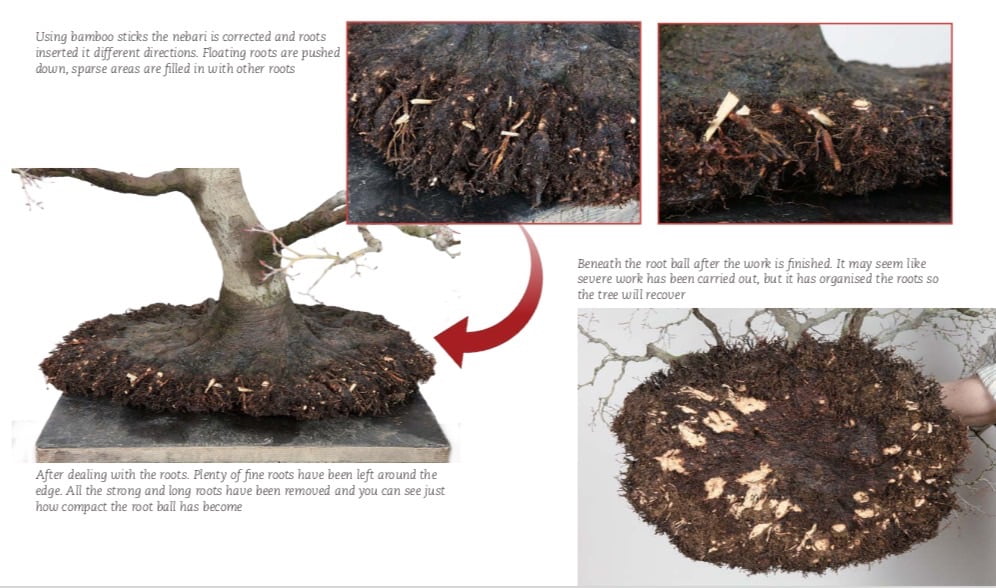
- Using bamboo sticks the nebari is corrected and roots inserted it different directions. Floating roots are pushed down, sparse areas are filled in with other roots
- After dealing with the roots. Plenty of fine roots have been left around the edge. All the strong and long roots have been removed and you can see just how compact the root ball has become
- Beneath the root ball after the work is finished. It may seem like severe work has been carried out, but it has organised the roots so the tree will recover
Even more severe work
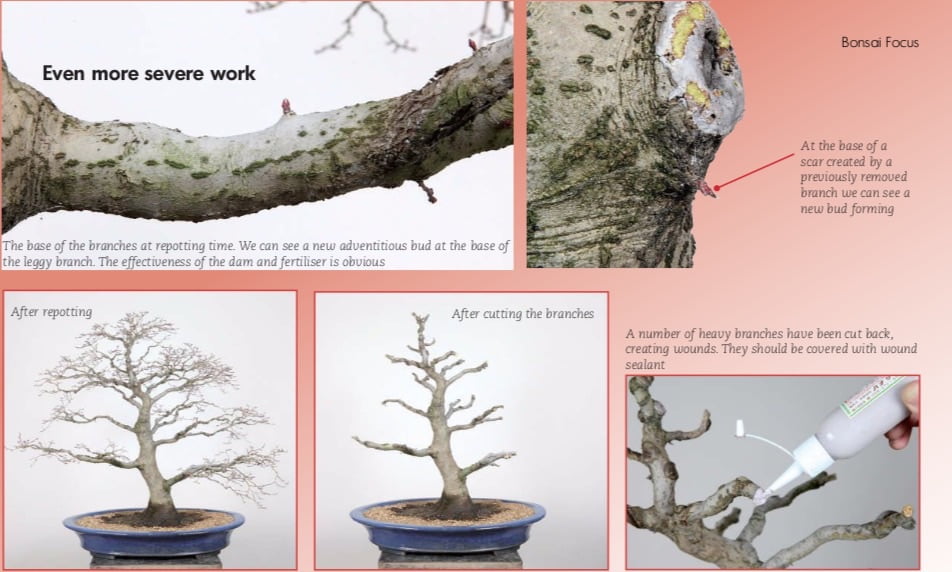
- The base of the branches at repotting time. We can see a new adventitious bud at the base of the leggy branch. The effectiveness of the dam and fertiliser is obvious
- At the base of a scar created by a previously removed branch we can see a new bud forming
- After repotting
- After cutting the branches
- A number of heavy branches have been cut back, creating wounds. They should be covered with wound sealant
No structure
Looking at the structure once again during repotting, Mr Ishii says, ‘It isn’t going to work . . .’ The entire structure of the tree has been damaged so much that carrying on as it is would be inadvisable. Branches have become leggy or too thick, large wounds created and there’s an entire lack of internal branches.
Mr Ishii cuts many branches halfway along in a bold and daring move. It may seem very severe, but he was confident due to the strong signs of recovery when repotting. Once a tree starts to recover, its resurrection can be unexpectedly rapid.
July 2013
It’s the year following the drastic work and the regeneration work continues. Each branch is full of energy and vigour, brimming with new buds. The wounds are healing well.
Along with the rejuvenation, approach grafts have been made at the base of branches in order to create secondary branching closer to the trunk.
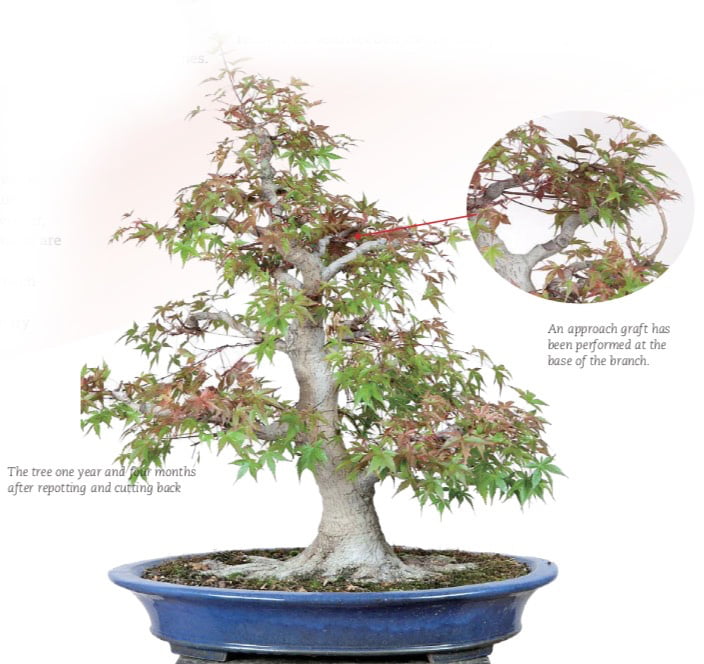
- An approach graft has been performed at the base of the branch.
- The tree one year and four months after repotting and cutting back
Dieback
After the last repotting, one section of the nebari started to dieback. When the health of a tree deteriorates and the roots become damaged, this can often be the cause. A large wound, 7cm long, 5cm wide has formed and a part of it has started to rot. It will be cleaned up and resealed in order to aid the healing process.

6th June 2014: Recovery in full swing
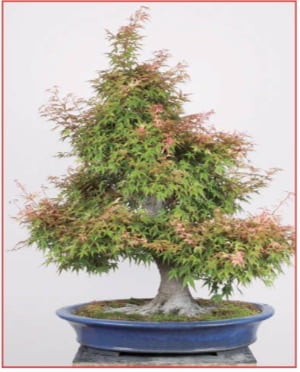
It is often said that it is more difficult to resuscitate a weak tree than to create a new one. If the cause of the damage cannot be discovered and treated quickly then it may be too late to recover. Mr Ishii spotted the cause of the problem early, saying ‘Water cannot reach the branches’ as he built the dam as a stopgap measure which worked perfectly.
The danger has passed for this tree and the recovery is in full swing. In order to create the branching suitable for a tree with such an impressive nebari, it will take several more year’s work. However, the day when it will be finished is not too far in the future.
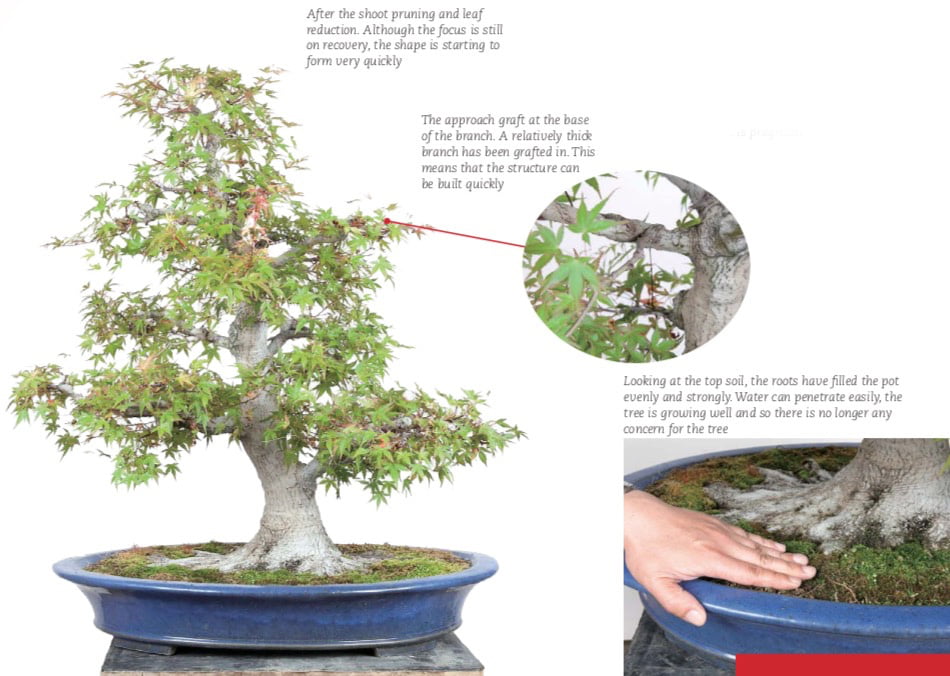
- After the shoot pruning and leaf reduction. Although the focus is still on recovery, the shape is starting to form very quickly
- The approach graft at the base of the branch. A relatively thick branch has been grafted in. This means that the structure can be built quickly
- Looking at the top soil, the roots have filled the pot evenly and strongly. Water can penetrate easily, the tree is growing well and so there is no longer any concern for the tree
Tiếng Việt
Hành trình cứu một cây Phong Beni Chidori (Acer palmatum var. ‘Beni Chidori’)
- Bài và ảnh: Kinbon magazine – Thao tác bởi bậc thầy Bonsai: Mr Haruyoshi Ishii (Vườn Ueharu-en)
Cây phong này bị yếu và héo cành do bị bó chặt trong chậu và rễ không thể hút nước. Một ‘cái đập’ đã được tạo ra xung quanh vành chậu để ngăn nước chảy tràn ra khỏi bề mặt. Ở đây chúng sẽ chia sẻ kết quả của kỹ thuật đó và theo dõi quá trình tái sinh của cây.





- Bây giờ một sợi dây thứ hai được thêm vào và ở giữa hai sợi dây, phân bón dạng bánh được đặt. Nước sẽ thu thập và giúp phân giải phân bón, hỗ trợ sự phục hồi của cây
- Số lượng lá đã được giảm đi để bộ rễ cân bằng lượng nước bị thoát hơi. Trong tình huống này, vào mùa hè nắng nóng cao độ, không thể sang chậu và biện pháp khẩn cấp này là cách tốt nhất để thực hiện
- Chín tháng sau công việc trước, thời điểm sang chậu đã đến

- Công việc bắt đầu bằng việc đưa cưa rễ vào

Mùng 06 tháng 03 năm 2012
Đập được đặt vào tháng 6 năm ngoái là một biện pháp tình thế cho đến thời điểm truyền thống để sang chậu. Kiểm tra kỹ rễ không thấy có dấu hiệu thối rễ chính, thay vào đó là một số rễ dày mọc xung quanh chậu. Ở trung tâm của cái này, chúng ta có thể thấy một số rễ mới, mịn, màu trắng.
Chúng ta có thể thấy được hiệu quả của đập. Nước có thể ngấm vào được rễ trong khi trước đó nước bị rửa trôi, nguyên nhân khiến cho cành cây bị chết. Khi cây bị bó chặt vào chậu và rễ mọc dày đặc, điều cần thiết là đảm bảo rằng nước thấm được vào giữa chậu.
Bóng rễ

- Chu vi bên ngoài được làm nhỏ lại một chút và phần đất chính sẽ được loại bỏ
- Lần này rễ sẽ được làm sạch sẽ hoàn toàn và tươi mới
- Dùng vòi phun tia để loại bỏ lớp đất cũ

- Thành quả sau khi làm sạch rễ.
- Có rất nhiều rễ không cần thiết mọc ở bên dưới thân cây khiến người ta không rõ đã bao lâu kể từ lần cuối cùng cây Bonsai này được sang chậu. Những rễ không quá dày có thể được cắt tỉa bằng kéo cắt rễ.
- Sợi dây gai làm con đập đã bắt đầu mục nát.
Thao tác với rễ

- Rễ mọc đâm xuống luôn phải được cắt lại, trong trường hợp này chúng tôi sử dụng kìm cắt vết lõm
- Gốc dày và nặng được cắt bỏ gần mép ngoài bằng máy cắt
Từ phía dưới của bóng rễ dày và quấn vào nhau, chúng ta thấy rằng một số rễ khoẻ đang mọc ra. Đây không phải là điều chúng ta muốn xảy ra; chúng ta muốn có rễ bên ở các phần phía trên mọc ra nhiều hơn. Để ngăn chặn rễ phát triển dưới thân và bóng rễ, nó sẽ được cắt càng nhiều càng tốt. Đó là bước tiếp theo trên con đường phục hồi.
Xử lý rễ bề mặt

- Có 3 rễ phụ mọc ra từ rễ dày X. A bị chết và bị cắt bỏ
- B là một rễ khá dày với một số rễ mỏng hơn nổi lên một ở dọc thân
- C là loại rễ rất dày và khỏe. Nếu cây được chăm sóc thường xuyên hơn, những rễ như thế này sẽ không phát triển
- C được lấy ra khỏi gốc của rễ. Những rễ thẳng mạnh như thế này nên luôn được loại bỏ

- Dùng que tre nắn chỉnh phần rễ gốc nebari và chỉnh rễ cây vào các hướng khác nhau. Rễ nổi bị đẩy xuống, chỗ thưa hơn nên để rễ khác lấp vào
- Sau khi xử lý rễ. Rất nhiều rễ tốt đã được để lại xung quanh rìa. Tất cả các rễ dài và khỏe đã được cắt bỏ và bạn có thể thấy bóng rễ đã trở nên nhỏ gọn như thế nào
- Bên dưới bóng gốc sau khi công việc kết thúc. Có vẻ như công việc khó nhất đã được thực hiện, và quy trình này đã tổ chức rễ tốt để cây có thể phục hồi
Những công việc phức tạp khác

- Phần gốc của cành lúc thay chậu. Chúng ta có thể thấy một chồi mới đầy tham vọng ở gốc của cành khẳng khiu này. Hiệu quả của đập và phân bón là rất rõ ràng
- Ở đáy vết sẹo được tạo ra bởi việc cắt cành trước đây, chúng ta có thể thấy một chồi mới hình thành
- Sau khi thay chậu
- Sau khi cắt cành
- Một số cành to sẽ bị cắt và tạo ra vết thương. Chúng nên được bao phủ bởi chất bịt kín vết thương
Không có cấu trúc
Nhìn vào cấu trúc một lần nữa trong quá trình thay chậu, ông Ishii nói, ‘Nó sẽ không thành công. . . ‘ Toàn bộ cấu trúc của cây đã bị hư hại rất nhiều nên việc tiếp tục duy trì nó là điều không thể tránh khỏi. Các nhánh trở nên dài hoặc quá dày, tạo ra các vết thương lớn và thiếu toàn bộ nhánh bên trong.
Anh Ishii đã cắt nhiều nhánh dọc theo một chuyển động táo bạo và mạnh mẽ. Nó có vẻ rất phức tạp, nhưng anh ấy tự tin vì các dấu hiệu phục hồi mạnh mẽ khi thay chậu. Một khi cây bắt đầu phục hồi, sự hồi sinh của nó có thể nhanh chóng không ngờ.
Tháng 7 năm 2013
Đó là năm tiếp theo công việc phức tạp và công việc tái tạo được tiếp tục. Từng nhánh cây tràn đầy năng lượng và sức sống, bừng lên những chồi non mới. Các vết thương thì đang lành.
Cùng với việc tái tạo, các phương pháp ghép tiếp cận đã được thực hiện ở gốc của các cành để tạo ra các cành thứ cấp gần với thân cây.

- Ghép tiếp cận đã được thực hiện ở gốc của nhánh.
- Cây một năm bốn tháng sau khi được thay chậu và cắt tỉa
Chết lại
Sau lần thay chậu cuối cùng, một phần gốc nebari bắt đầu chết dần. Khi sức khỏe của cây xấu đi và rễ bị hư hại, đây thường có thể là nguyên nhân. Một vết thương lớn, dài 7cm, rộng 5cm đã hình thành và một phần của nó đã bắt đầu thối rữa. Nó sẽ được làm sạch và đóng lại để hỗ trợ quá trình chữa bệnh.

06/06/2014: Phục hồi hoàn toàn

Người ta thường nói rằng khó phục hồi một cây yếu hơn là tạo dáng một cây mới. Nếu nguyên nhân của tổn thương không được phát hiện và điều trị nhanh chóng thì có thể đã quá muộn để cứui. Ông Ishii đã sớm phát hiện ra nguyên nhân của vấn đề và nói rằng ‘Nước không thể đến các nhánh cây’ khi ông xây dựng con đập như một biện pháp tức thời hoàn hảo.
Mối nguy hiểm đã qua đối với cây Bonsai này và sự phục hồi đang diễn ra mạnh mẽ. Để tạo ra nhánh phù hợp cho một cây với một gốc nebari ấn tượng như vậy, sẽ mất vài năm làm việc. Tuy nhiên, ngày mà nó hoàn thành không còn quá xa trong tương lai.

- Sau khi tỉa chồi và cắt giảm lá. Mặc dù vẫn đang tập trung vào việc phục hồi, nhưng hình dạng cây đang bắt đầu hình thành rất nhanh
- Ghép nhánh ở gốc của cành. Một nhánh tương đối dày đã được ghép vào. Điều này có nghĩa là cấu trúc có thể được xây dựng nhanh chóng
- Nhìn lớp đất phía trên, rễ đã lấp đầy chậu đều và khỏe. Nước có thể thẩm thấu dễ dàng, cây đang phát triển tốt và vì vậy không còn phải lo lắng cho cây nữa
